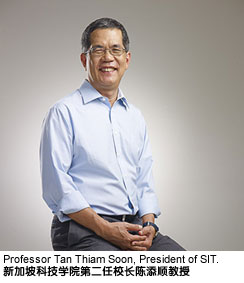 Although polytechnic students can already offer a lot to the workplace, Professor Tan Thiam Soon, President of the Singapore Institute of Technology (SIT), is convinced that an SIT experience, which combines both work and study, will further develop these students into valuable workers with a lifelong learning mindset. Although polytechnic students can already offer a lot to the workplace, Professor Tan Thiam Soon, President of the Singapore Institute of Technology (SIT), is convinced that an SIT experience, which combines both work and study, will further develop these students into valuable workers with a lifelong learning mindset.
Think of the Singapore Institute of Technology (SIT), if you will, as a bridge between Singapore's polytechnic graduates and degrees from reputable overseas universities.
Established in 2009, SIT was set up to cater to the aspirations of polytechnic graduates wanting a university degree. At full capacity, SIT will be able to admit 3,500 students every year, with a total enrolment of 10,000 to 12,000 students.
SIT President, Professor Tan Thiam Soon, also confirmed that degrees offered at SIT would be a continuation of what the polytechnic students have learnt.
As a baseline, he recognises that polytechnic graduates are already fully equipped with skills that are applicable in the workplace, and he has no intentions of deviating from that. "Polytechnic graduates come in with wonderful characteristics which are needed in the future - the willingness to roll up their sleeves to get things done and to do things when others won't, as well as adaptability and the willingness to change. We embrace these characteristics, and we ask students to put them to use," he said.
Rather, he wants to build a curriculum and pedagogy that will enhance the major strengths of the graduates and their understanding of the future. This is being done in two ways: one through the traditional classroom environment where learning is interactive and personalised with relatively small numbers in each class, and the other through the work-study element which is key to SIT's course delivery.
SIT also works with the polytechnics for closer course continuation.
"We will tell the polytechnics our plans, and we will work together in areas that require a longer gestation period than they can provide. In this way their students see SIT as a continuation of their education. The polytechnics are our most important partners because they supply us with students. The better the students are prepared, the better fit they will have with SIT. Our intention is to build, enhance and leverage on the polytechnic curriculum," Professor Tan said.
Going to polytechnic before university offers another advantage. "More students should be given the choice of going to the polytechnics to pick up real skills that interest them, and this early introduction will reduce mismatches and pressures in getting a university degree," said Professor Tan. "It is critical for Singapore to avoid the problem of unemployed graduates. Our focus in SIT is to equip students to go into industry. So our DNA will be built on the strength of polytechnic graduates."
What is the SIT DNA?
What SIT will give its students are three key abilities, or what Professor Tan calls the SIT DNA.
Thinking Tinkers
This means that they will be adaptable, resourceful, and know how to think through doing.
"In the past, people tended to think these qualities were secondary to academic abilities, but I don't think that will be the case in the 21st century," said Professor Tan. "Things in the 21st century are going to change very fast, and you will need to be adaptable to survive in the long run."
In order to develop these qualities, courses at SIT are more hands-on and are aligned to industry needs.
>> More
To read full content, please subscribe
|